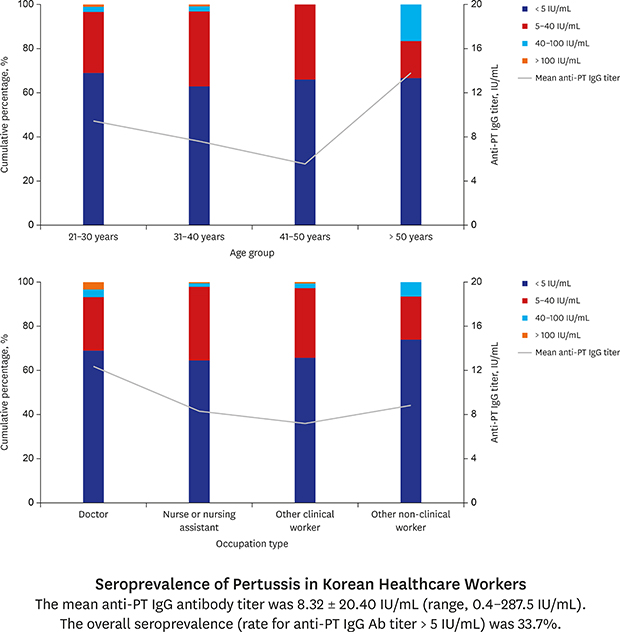1. Kilgore PE, Salim AM, Zervos MJ, Schmitt HJ. Pertussis: microbiology, disease, treatment, and prevention. Clin Microbiol Rev. 2016; 29(3):449–486.

2. Matlow AG, Nelson S, Wray R, Cox P. Nosocomial acquisition of pertussis diagnosed by polymerase chain reaction. Infect Control Hosp Epidemiol. 1997; 18(10):715–716.

3. Gehanno JF, Pestel-Caron M, Nouvellon M, Caillard JF. Nosocomial pertussis in healthcare workers from a pediatric emergency unit in France. Infect Control Hosp Epidemiol. 1999; 20(8):549–552.

4. Bassinet L, Matrat M, Njamkepo E, Aberrane S, Housset B, Guiso N. Nosocomial pertussis outbreak among adult patients and healthcare workers. Infect Control Hosp Epidemiol. 2004; 25(11):995–997.

5. Centers for Disease Control and Prevention (CDC). Outbreaks of pertussis associated with hospitals--Kentucky, Pennsylvania, and Oregon, 2003. MMWR Morb Mortal Wkly Rep. 2005; 54(3):67–71.
6. Pascual FB, McCall CL, McMurtray A, Payton T, Smith F, Bisgard KM. Outbreak of pertussis among healthcare workers in a hospital surgical unit. Infect Control Hosp Epidemiol. 2006; 27(6):546–552.

7. Baugh V, McCarthy N. Outbreak of Bordetella pertussis among oncology nurse specialists. Occup Med (Lond). 2010; 60(5):401–405.
8. Sydnor E, Perl TM. Healthcare providers as sources of vaccine-preventable diseases. Vaccine. 2014; 32(38):4814–4822.

9. Hsieh YH, Liu J, Tzeng YH, Wu J. Impact of visitors and hospital staff on nosocomial transmission and spread to community. J Theor Biol. 2014; 356:20–29.

10. The Korean Society of Infectious Diseases. Vaccination for Adult. 2nd ed. Seoul: MIP;2012.
11. Lee SY, Han SB, Bae EY, Kim JH, Kang JH, Park YJ, et al. Pertussis seroprevalence in Korean adolescents and adults using anti-pertussis toxin immunoglobulin G. J Korean Med Sci. 2014; 29(5):652–656.

12. Lee SY, Choi UY, Kim JS, Ahn JH, Choi JH, Ma SH, et al. Immunoassay of pertussis according to ages. Korean J Pediatr Infect Dis. 2012; 19(2):55–60.

13. Kim S, Oh H, Ham O, Chung MH, Seo W. Susceptibility and factors of pertussis vaccination adherence in Korean health care workers. Am J Health Behav. 2010; 34(1):45–53.

14. Rodríguez de la Pinta ML, Castro Lareo MI, Ramon Torrell JM, García de Lomas J, Devadiga R, Reyes J, et al. Seroprevalence of pertussis amongst healthcare professionals in Spain. Vaccine. 2016; 34(8):1109–1114.

15. Mackey JE, Wojcik S, Long R, Callahan JM, Grant WD. Predicting pertussis in a pediatric emergency department population. Clin Pediatr (Phila). 2007; 46(5):437–440.

16. Wright SW, Edwards KM, Decker MD, Lamberth MM. Pertussis seroprevalence in emergency department staff. Ann Emerg Med. 1994; 24(3):413–417.

17. Urbiztondo L, Broner S, Costa J, Rocamora L, Bayas JM, Campins M, et al. Seroprevalence study of B. pertussis infection in health care workers in Catalonia, Spain. Hum Vaccin Immunother. 2015; 11(1):293–297.
18. Wendelboe AM, Van Rie A, Salmaso S, Englund JA. Duration of immunity against pertussis after natural infection or vaccination. Pediatr Infect Dis J. 2005; 24(5):Suppl. S58–S61.

19. Choe YJ, Park YJ, Jung C, Bae GR, Lee DH. National pertussis surveillance in South Korea 1955–2011: epidemiological and clinical trends. Int J Infect Dis. 2012; 16(12):e850–e854.

20. Choe YJ, Kim JW, Park YJ, Jung C, Bae GR. Burden of pertussis is underestimated in South Korea: a result from an active sentinel surveillance system. Jpn J Infect Dis. 2014; 67(3):230–232.

21. Chungnam National University. Korea Center for Disease Control and Prevention. 2013 National Immunization Rate Survey. Cheongju: Korea Center for Disease Control and Prevention;2014.
22. Sabbe M, Vandermeulen C. The resurgence of mumps and pertussis. Hum Vaccin Immunother. 2016; 12(4):955–959.

23. Ryu S, Kim JJ, Chen MY, Jin H, Lee HK, Chun BC. Outbreak investigation of pertussis in an elementary school: a case-control study among vaccinated students. Clin Exp Vaccine Res. 2018; 7(1):70–75.

24. Park S, Lee MG, Lee KH, Park YB, Yoo KH, Park JW, et al. A multicenter study of pertussis infection in adults with coughing in Korea: PCR-based study. Tuberc Respir Dis (Seoul). 2012; 73(5):266–272.

25. Kwon HJ, Yum SK, Choi UY, Lee SY, Kim JH, Kang JH. Infant pertussis and household transmission in Korea. J Korean Med Sci. 2012; 27(12):1547–1551.







 PDF
PDF Citation
Citation Print
Print




 XML Download
XML Download